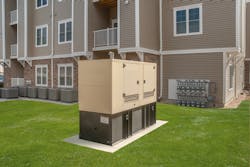NEC Requirements for Optional Standby Systems
Standby systems are optional when they are intended to provide power to facilities or property where life safety does not depend upon the performance of the system.
Article 702 provides the requirements for permanently installed optional standby systems (OSS). Did you know that portable alternative power supplies, when arranged for a connection to premises wiring, are also covered by Article 702? Some highlights include:
- OSS equipment must be suitable for the fault current at its terminals [702.4].
- Where you have automatic transfer, the standby source must be able to supply the full load the automatic transfer equipment transfers [702.4(B)(2)(a)].
- If your OSS is installed to permit parallel operation with the normal source, it must also meet the requirements of Article 705 [702.5(E)].
- Where practical, audible and visual signals must be provided to indicate malfunction of the OSS and to indicate when the OSS is carrying load [702.6]. This rule does not apply to portable standby power sources.
- Wiring for the OSS can occupy the same raceways, cables, boxes, and cabinets with other general wiring [702.10].
About the Author

Mark Lamendola
Mark is an expert in maintenance management, having racked up an impressive track record during his time working in the field. He also has extensive knowledge of, and practical expertise with, the National Electrical Code (NEC). Through his consulting business, he provides articles and training materials on electrical topics, specializing in making difficult subjects easy to understand and focusing on the practical aspects of electrical work.
Prior to starting his own business, Mark served as the Technical Editor on EC&M for six years, worked three years in nuclear maintenance, six years as a contract project engineer/project manager, three years as a systems engineer, and three years in plant maintenance management.
Mark earned an AAS degree from Rock Valley College, a BSEET from Columbia Pacific University, and an MBA from Lake Erie College. He’s also completed several related certifications over the years and even was formerly licensed as a Master Electrician. He is a Senior Member of the IEEE and past Chairman of the Kansas City Chapters of both the IEEE and the IEEE Computer Society. Mark also served as the program director for, a board member of, and webmaster of, the Midwest Chapter of the 7x24 Exchange. He has also held memberships with the following organizations: NETA, NFPA, International Association of Webmasters, and Institute of Certified Professional Managers.
